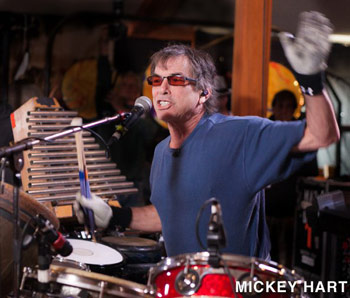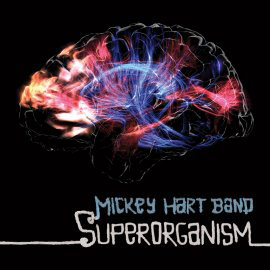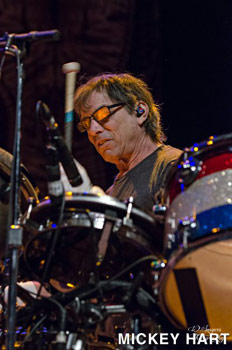Legendary Grateful Dead Drummer Mickey Hart
A Multi Universe Road Warrior

An Interview with Mickey Hart
By Mariah Fleming
Mickey Hart, legendary Grateful Dead drummer, ethnomusicologist and Rock and Roll Hall of Famer, turns 70 this month. And Hart is living proof that age is just a number. In August, Hart released his second record in two years, the groundbreaking “SuperOrganism.” On this project, Hart once again collaborated with Grateful Dead lyricist Robert Hunter. “SuperOrganism” is mind blowing musically and lyrically. And Mickey Hart is bringing his band along with special guests The Tea Leaf Trio to perform in Tempe Tuesday September 10th at The Marquee Theatre. Tickets are $27 or $30 day of show. This concert marks his third Valley show in as many years. A portion of ticket fees sold through Mickeyhart.net for the SUPERORGANISM tour will help fund Hart’s collaborative Rhythm and the Brain project.
Hart spends a lot of time on the road with The Mickey Hart Band, but that's not the extent of his adventures. Hart's a multi universe road warrior, marrying music and science in ways that have never been done before. On his 2012 album "Mysterium Tremendum" Hart delved into the 'macro' through his work with NASA turning light waves from the sun into sound. If you missed him on his "Mysterium Tremendum" tour, you missed hearing something never before heard. Hart played his 'sonification' of light waves from the sun for an SRO audience in Phoenix. The moment the audience heard that ethereal sound, the human antennae in the room picked up on it, moving everyone to blissful silence.

When I told him I was at that show, he said: "This is a much better version of that, only now we’re moving from the 'macro' to the ‘micro’. We’re into the brain instead of just the cosmos.” He went on to explain in a recent phone interview, “All of these vibrations that are passing above us, around us and through us, they all have a sound.” These sounds are woven into the music on "SuperOrganism." For the past several years, Hart has been journeying into the worlds of rhythm hidden within our bodies, researching the effect of rhythm on the brain in his Rhythm and the Brain project with Dr. Adam Gazzaley, neuroscientist from UCSF. The musical results are astounding. Hart's brain wave signals are re-imagined in sound using an EEG cap with electrodes. It reads the throbs and signals of the brain in real time. Hart will don an EEG cap for part of each concert to allow the audience to experience what he's doing. He has also sonified the sounds of stem cells, and heart rhythms for “SuperOrganism.” To see an example of this go here. Hart’s having fun with this, but he’s not kidding around: "The brain is rhythm central There’s a lot of power in music that we don’t know of, so the only way to prove it is science.” he declared.
Mickey Hart Interview, Part One
Q.Did you record “SuperOrganism” live in studio with all the musicians?
A. Oh yes. This was recorded here (San Francisco) with real humans, and we also used computers too. I didn't record it all at once. It was in stages. I go on tour, so it took about a year getting the sound. A lot of work went into preparing for this kind of work in the micro.

Q. You have many of the same musicians working with you on “SuperOrganism” that you worked with before, right?
A. (very enthusiastically) Oh, yes! These are amazing musicians! Yes, yes! Amazing musicians! And Robert Hunter writing the words. Jesus, it just all came together in this beautiful flash of inspiration. Yeah, this was one of the good ones!
Q. All the tracks are very strong. I didn't want to stop listening to it.
It's mesmerizing stuff. It really took my imagination for a ride. It made a connection with me on some level that is indefinable.
A. It made a connection with you, as it will with others, as it did with me, because the brain is ‘rhythm central.' The CD was taking your imagination. It's about vibration. And you're getting it; you're pondering it. So, it's not just a CD, which it is; it's not just entertaining and giving you pleasure, which it does; but it's something ‘wholly other’ in a way.
Q. In the video you did with neuroscientist Dr. Adam Gazzaley, "Life's Rhythm Re-imagined" you wear an EEG cap and the data gets projected on a big screen in real time. It's amazing. The concept of visualizing our brain rhythms in real time to help us control them is fascinating and sort of scary.
A. It's not really scary at all once you look at the cranium. I've seen it 40 feet tall. It's amazing, it's like awe…you're looking at yourself, what makes YOU and interacting with it in some way and that's really powerful. That means you're creating some kind of language; musical language for me. When you look at the activity of the brain, you can think of it as a city, always at work and moving 24/7. It's moving in a different rhythm that I can't quite understand yet, and it has a sound to it. So it's not only in real time that you see it, but you hear it.
Q.So these sounds of the brain waves, heart rhythm, DNA and all are the raw data and you re-imagine the data to create sound. How do you do that?
A. I'll give you an overview. I use machines, I use robots, and I use algorhythms and computers that can change the forms. You can change the form to anything. Light to sound, radiation to light and sound; anything is doable in the digital world.
Q. Can you explain more about the science behind this?
A. This is synesthesia...when you bring two energy forms together and get the real picture. So when I see my brain, I'm seeing what I am, and I start to play into it. I’m starting to find out what does what. Then Dr. Gazzaley and the wonderful scientists I’m working with at UCSF and the Gladstone Institute analyze it in the lab. They give me this info. I’m not a scientist. I’m a rhythmist. And these guys are at the top of their field and they're as interested in vibration as I am.
Q. Why? What application can it have for science?
A. Because it’s at the bottom of everything they do. Stem cell, brain wave, heart rhythm, scar tissue of the heart, DNA… it all comes down to vibration and rhythm. That’s the common denominator of all life on this blue green spinning rock. Finding out about it, getting interested in interacting with it seems like, I hate to say it, a 'no brainer.' (laughs)
Q. Last time I interviewed you, you were working with NASA turning light waves from the sun into sound waves. What got you interested in working with the brain the same way?
A. I realized that the brain has been given short shrift. We know more about the ocean than we do about our brains. And the brain is us. It's what makes us go. Machines like radio telescopes gather the light radiation of the cosmos and now machines can read brain waves, heart rhythms, DNA, stem cells and turn those electrical signals into sound. I realized I could compose to it, probe it, and find out what the rhythm is saying and how it's being influenced by the neurology of it.
Q. How far along is the research in decoding this data and how do you hope it can be used?
A. Is it going to cure a tumor? Perhaps. Is it going to relieve depression? Perhaps. Is it going to work with dementia? Perhaps. So all these things we know, kind of, sort of, seat of the pant-sing it. But NOW science is stepping in and re-evaluating or ‘re-imagining’ as they say now (laughs) the brain and the body. Your brain is taking care of business. So wouldn’t you want to treat your brain, or want to know all you can about it, on a real cool, fun basis without having to learn all about what the brain is made up of and all that stuff?
Q. Sure I do. Understanding the brain will take us on seemingly endless paths.
A. Well, I’m playing that journey and now it’s all so much clearer. Now I’m 70 years old. I’ve been playing rhythm since I was about three years old, so, 67 years as a rhythmist. And even though I didn’t know what I was doing when I was 3,4,5,6, I was tapping stuff out everywhere and being engaged in the idea of rhythm captivating your imagination. So there was a reason for that then, and there’s a reason for it now.
Editor’s Note: In the next part of this interview, we’ll talk to Mickey Hart about how rhythm and vibration can create consciousness, how music can affect consciousness, and the plans for Congressional hearings on his research into the brain. Hart is debuting a new work, “Rhythms of the Universe,” in Washington, DC at the end of September.
September 3, 2013
Contact the author of this article at Editor@MusicAndMoreAZ.com.